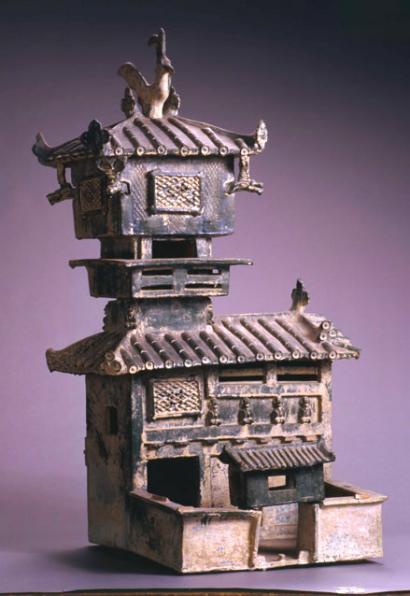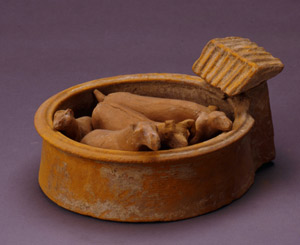
Building with a tower. Late Han, middle of the 2nd century |
|
ROYAL MUSEUMS OF ART AND HISTORY
Parc du Cinquantenaire 10
B-1000 BRUSSELS
INFORMATION:
Tel. +32 (0)2 741 72 11 Site : www.rmah.be
Guided tours : Tel +32 (0)2 741 72 14 Email : sec@mrah.be
OPENING HOURS:
Tuesdays-Sundays, from 10 a.m. to 5 p.m (the ticket office closes at 4 p.m.)
‘Nocturnes’ till 10 p.m every last Thursday of the month, except during December – thus on January 31, February 28, March 27.
Closed on Mondays, December 25 and January 1.
ENTRANCE FEES:
9 €, 8 €, 2 €(notably for school groups and the young from 13 to 18).
Free for children younger than 13.
CURATORSHIP:
Nicole De Bisscop
PRESS CONTACT:
Bart Suys Tel. +32 (0)2 741 73 00
Email : b.suys@kmkg.be

|
How did people live in China 2000 years ago? What shape did warehouses, houses or latrines have? The objects found in the tombs of dignitaries in Henan have allowed us to bring precise answers to these questions. They are indeed small-scale models of buildings, very faithful to the original constructions and which project us into the daily universe of the beginnings of Imperial China. We spoke about this very original exhibition when it opened. It will last until the end of the month of April. Do not miss it...
The rich collection of the museum of Henan
The province of Henan, which the Yellow river flows through, is one of the cradles of Chinese civilisation. Under the Han dynasty (from 206 B.C. until 220 A.D.), which reigned immediately following the country's unification, architecture reached an apotheosis. The population lived in houses with internal courtyards, had warehouses and pavilions on the water. The technique of the wooden structure and corbels helped build towers of various floors. The nearly 200 small-scale models that demonstrate it are on loan from the museum of Henan. They were built over a period of time of two thousand years (from the IInd century B.C. up to the XVIIIth century) and some of them are quite imposing (up to 2 meters tall).
Funerary sculptures
These small-scale models were deposited in the tombs, next to the bodies of the deceased. In the passage from one life to another, the individual was expected to keep his social status. The reconstruction of his residence was therefore an essential element of the funerary furniture. While the noble or religious architecture, in stone, left traces in China, it was not the case of the common buildings. Made in perishable materials - wood, beaten earth, bamboo or sun-dried clay squares -, they have all disappeared. The small-scale models of the Henan tombs have given us precious information: they were indeed faithful copies of the originals, from the building's structure up to its ornaments.
From the water pavilion to the latrine
The typology of the buildings thus reproduced is very large. The most spectacular are the towers with various floors, built on a beaten earth foundation with a framework resting on wooden pillars that could be surrounded by water. In the exhibition, architecture elements from that time, found in the archaeological diggings - tile nozzles, floor squares or mural bricks - allow us to look closely at an often very refined decoration in relief. Next to the residences, farms, warehouses and grain silos, more modest public lavatories bring a touching light on everyday life: latrines, workshops, wells and mills, cereal sifters or kitchen ovens. Characters unveiled in these tombs - archers, pottery makers, cooks and farmyard animals - give the final touch to the illusion of reality of these «models» that have gone through twenty centuries of time to reach us.
PUBLICATION
Exhibition catalogue published by the Fonds Mercator, 32 x 28 cm, 272 p, € 35 (in the exposhop) .
Illustration: Sheepfold. Late Han.
|









